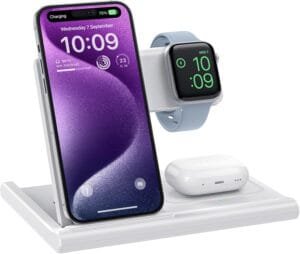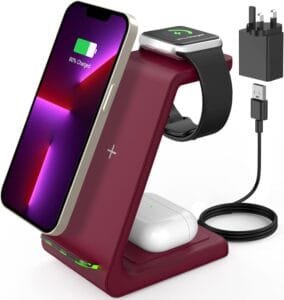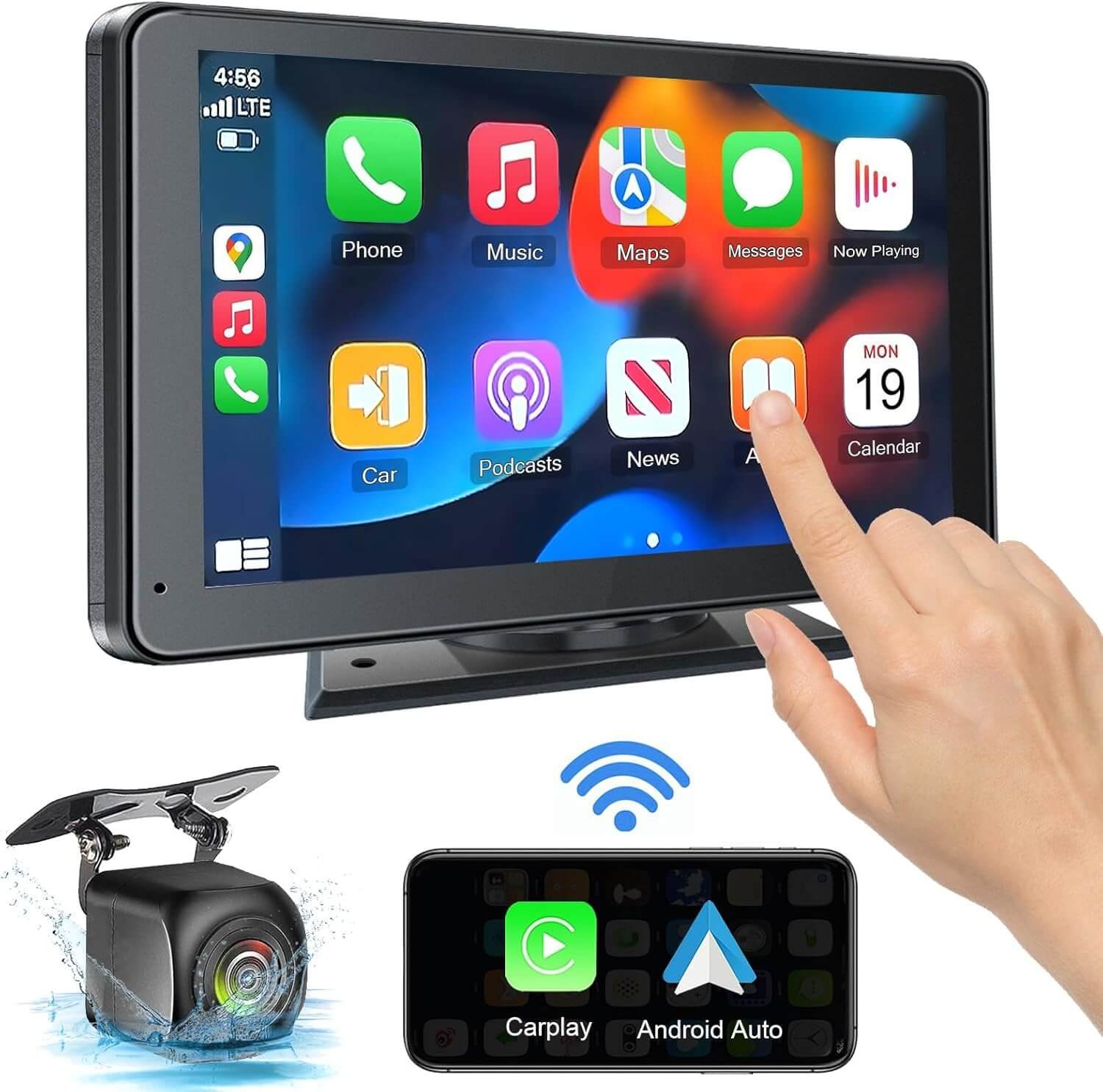Introduction to Wireless Charging
Wireless charging represents a significant advancement in the way we power our mobile devices, particularly smartphones. This innovative technology has gained notable popularity in recent years, especially among users of Apple and Android devices. The convenience of being able to charge a phone simply by placing it on a charging pad has resonated with many, encouraging a shift away from traditional wired charging methods.
The underlying technology behind wireless charging primarily involves inductive charging. This system uses electromagnetic fields to transfer energy between two coils: one within the charging pad and another within the device itself. When a compatible device is positioned on the charging pad, these coils align, enabling energy transfer without the need for a physical connection. As a result, users enjoy not only the reduced clutter of cables but also an ease of use that aligns with modern lifestyles.
Moreover, the introduction of the Qi standard has further fueled the acceptance of wireless chargers across various brands. This universal compatibility ensures that users can take advantage of wireless charging regardless of their device manufacturer, creating a more cohesive charging experience. In addition to enhancing convenience, wireless charging minimizes wear and tear on charging ports, leading to longer device lifespans. This demonstrates how technology is evolving to cater to users’ needs while simplifying their daily routines.
As we delve deeper into the specifics of wireless chargers for both Apple and Android smartphones, it becomes clear that this technology brings numerous benefits, though not without its set of drawbacks. The balance of convenience and efficiency continues to shape the landscape of mobile charging solutions.
How Wireless Chargers Work
Wireless charging is a technology that enables the transfer of energy from a charger to a device without the need for physical connectors. At the heart of this process is the principle of electromagnetic induction, which allows energy to be transferred over short distances. In wireless charging systems, two main components work together: the transmitter, which is embedded in the charging pad, and the receiver, which is built into the smartphone.
When a smartphone is placed on a wireless charging pad, the transmitter coil within the charger generates an alternating magnetic field. This magnetic field induces an electric current in the receiver coil located in the phone. The coils are designed to resonate at similar frequencies to facilitate efficient energy transfer. The energy generated is then converted into direct current, which is used to charge the smartphone’s battery.
Communication between the charger and the smartphone is essential to ensure safe and effective charging. When a device is placed on a charging pad, it sends a signal to the charger to confirm its identity. This process helps to regulate power delivery, preventing overheating and ensuring that the device receives the correct amount of energy. Additionally, many wireless chargers incorporate safety features, such as foreign object detection, which ensures that only compatible devices are charged.
The efficiency of wireless charging has improved significantly over recent years. While traditional wired charging can transfer energy with an efficiency rate of up to 100%, wireless charging typically operates at around 75-80% efficiency. Factors such as the alignment of the coils, the distance between them, and the presence of obstacles can affect energy transfer. However, advancements in technology continue to address these challenges, making wireless charging a convenient and increasingly efficient option for both Apple and Android devices.
Latest Wireless Chargers for Apple Devices
The landscape of wireless charging for Apple devices has seen significant advancements in recent times, particularly with the introduction of the MagSafe charger. This system, designed specifically for iPhone models starting from the iPhone 12 and onward, utilizes magnets to ensure proper alignment between the phone and charging pad, allowing for optimal energy transfer.
The latest MagSafe charger offers compatibility with a range of devices, supporting not only the newer iPhones but also the AirPods and Apple Watch when paired with suitable accessories. The charging speed is particularly noteworthy; it delivers up to 15W of power for iPhone 12 and later models, compared to the standard 7.5W for Qi wireless chargers. This enhanced speed makes it a preferred choice for users who prioritize efficiency in their charging routine.
Another option available for Apple users is the Anker Wireless Charger, which also supports the Qi standard. While it might not offer the magnetic alignment feature like MagSafe, it is compatible with a broad variety of Apple devices, including older iPhone models. This charger provides a maximum output of 10W for compatible devices, making it a practical alternative for those who do not have the latest iPhone models. Its design incorporates a non-slip surface to prevent devices from sliding during charging, ensuring convenience for users.
When considering the unique features of these wireless chargers, both the MagSafe and Anker solutions come equipped with temperature control and over-voltage protection, safeguarding devices during the charging process. Overall, the latest wireless charging options for Apple phones highlight a mix of functionality and design, catering to diverse user needs while enhancing the convenience of everyday technology usage.
Latest Wireless Chargers for Android Devices
The advancement of wireless charging technology has been significant, particularly catering to the needs of Android users. The latest wireless chargers designed for Android smartphones provide a range of features that enhance user convenience and efficiency. Many of these devices incorporate Qi technology, which is widely adopted by Android manufacturers, ensuring compatibility across several models. In this section, we will examine some of the best options available today.
One standout option is the Samsung Wireless Charger Duo Pad. This versatile charger allows users to charge two devices simultaneously, including smartphones and wearable devices. It delivers fast charging capabilities, reaching up to 15W for compatible devices. Additionally, its sleek design complements the aesthetics of modern Android smartphones, making it an appealing choice for users who value both function and form.
Another excellent choice is the Anker Wireless Charger. Known for its reliability, Anker offers a range of chargers that suit various needs. Their PowerWave Pad is particularly noteworthy, providing up to 10W charging for most Android devices and featuring anti-slip technology to keep phones securely in place while charging. Moreover, its compact size makes it suitable for use at home or on the go, appealing to a wide audience.
The RAVPower 10W Wireless Charger is also a noteworthy contender. Its robust design promotes effective heat dissipation, which is a critical feature for maintaining device longevity during charging. Additionally, the charger is equipped with foreign object detection to enhance safety, offering users peace of mind when powering their devices.
These developments highlight the growing market of wireless charging solutions for Android smartphones. With a variety of features and improved designs, these chargers not only facilitate quicker charging but also cater to the diverse preferences of users, ensuring that the convenience of wireless charging is within everyone’s reach.
Common Outputs of Wireless Chargers
Wireless chargers come with different output ratings that significantly influence their performance and user experience. The three most common output levels are 5W, 10W, and 15W. Each of these ratings affects charging times and device compatibility, which are essential factors for users considering the purchase of a wireless charging solution.
A 5W wireless charger is generally considered the baseline for charging smartphones wirelessly. This output level is typically sufficient for older devices or those with smaller batteries. While it may take longer to charge devices at this rate, many users appreciate the simplicity and convenience of this option, especially when considering that 5W chargers often come at a lower cost. However, it’s important to note that modern smartphones may take significantly longer to recharge fully with this output.
Moving up the scale, a 10W wireless charger is a popular choice for both Apple and Android phones. This output level provides a more efficient charging experience, generally reducing the time required to reach a full charge. Many current smartphones are compatible with 10W charging, making it a practical choice for users who desire quicker charging without needing to invest in higher-end models. Nevertheless, the actual charging speed may still be dependent on the phone model and its internal charging management system.
Finally, 15W wireless chargers represent the premium option in this category. This output level is typically reserved for newer devices that support fast wireless charging. Users can benefit from significantly reduced charging times, making it ideal for those who frequently find themselves in need of a quick battery boost. That said, compatibility is crucial, as not all smartphones can take advantage of the maximum output provided by these chargers. Overall, selecting an appropriate output level is vital to ensure a balance between charging speed and device compatibility.
Pros of Wireless Chargers
Wireless chargers offer numerous advantages that enhance the overall user experience of mobile devices. Perhaps the most notable benefit is the convenience they provide. Users can simply place their devices on the charging pad without the need to fumble with cables, particularly in low-light conditions or when multitasking. This ease of use makes wireless charging an attractive option for busy individuals who appreciate streamlined solutions.
Additionally, the use of wireless chargers significantly reduces the wear and tear on charging ports. Traditional charging methods often lead to wear on the connectors and ports, which can ultimately impair functionality or require device replacement. In contrast, wireless chargers rely on electromagnetic fields to transfer energy, eliminating direct contact and prolonging the longevity of essential device components.
Moreover, wireless charging contributes to a tidier and more organized environment. With the absence of tangled cords, users can enjoy a decluttered space, which is especially advantageous in settings such as offices or living rooms. This aspect not only enhances aesthetics but can also result in a more seamless and sophisticated ambiance within the space.
Furthermore, the growing integration of wireless charging in public spaces, such as cafes, airports, and hotels, signifies the technology’s increasing acceptance and convenience. As more establishments adopt this feature, users will find it increasingly convenient to charge their devices on the go. This trend highlights the potential for widespread adoption of wireless charging solutions across various environments, making it a vital consideration for both Apple and Android phone users.
In conclusion, the benefits of wireless chargers extend beyond mere convenience; they also offer significant advantages in device longevity, organization, and widespread accessibility, making them a valuable investment for consumers.
Cons of Wireless Chargers
While wireless chargers offer convenience, there are several drawbacks that users should consider before fully transitioning from traditional charging methods. One significant disadvantage is the slower charging speeds associated with wireless technology. Unlike wired chargers, which can deliver power to devices at a higher rate, wireless chargers often lag behind, especially in terms of fast charging capabilities. This slower charging speed can be particularly frustrating for users who rely on quick top-ups throughout the day.
Another concern is the potential heat generation during the charging process. Wireless charging pads often generate heat as the energy is transferred through the air, which can lead to overheating issues for both the charging pad and the device. Prolonged exposure to elevated temperatures can negatively impact battery health and overall device longevity. Users may find themselves in situations where they need to stop charging their devices to allow them to cool down, further complicating the user’s experience.
Additionally, proper alignment of the device on the charging pad can be a challenge. Many wireless chargers require precise placement to ensure optimal charging efficiency. Misalignment can lead to inconsistent charging and, in some cases, complete failure to charge. This issue can be particularly cumbersome for users who may need to frequently reposition their devices to achieve the desired charging connection.
Lastly, compatibility issues arise with certain phone cases and accessories. Some thicker or metal cases can interfere with the charging process, rendering wireless chargers ineffective. Users may need to remove their cases before charging, which diminishes the overall convenience that wireless chargers aim to provide. While wireless technology is continually evolving, being aware of these cons is essential for informed decision-making regarding charging options.
Future of Wireless Charging Technology
The landscape of wireless charging technology is continually evolving, with advancements poised to enhance both efficiency and user experience. One notable trend is the push for faster charging capabilities. Current wireless chargers often take longer to deliver a full charge compared to their wired counterparts. However, researchers and manufacturers are increasingly focused on developing systems that can deliver rapid charging without compromising safety. This effort includes innovations such as resonant inductive charging, which allows for greater power transfer over short distances, thereby optimizing charge times significantly.
Another fascinating development is the concept of long-range wireless charging. Traditional wireless charging systems typically require devices to be placed in close proximity to charging pads. Emerging technologies, however, are exploring the feasibility of charging devices from a distance. This could involve systems that use advanced resonance techniques or even microwave energy transmission, allowing users to charge their devices while moving about. Such technological advancements hold the potential to revolutionize our daily interactions with electronic devices, making charging simpler and more convenient.
Moreover, the integration of wireless charging into everyday environments is rapidly gaining momentum. Many manufacturers are now incorporating charging capabilities into furniture, such as desks and nightstands, and automotive interiors, making it possible to charge devices seamlessly while using them. This integration aims to create a frictionless experience, where users do not have to think about connecting cables or finding charging stations. As these technologies advance, one can anticipate a future where wireless charging is ubiquitous, enhancing both the functionality and aesthetic appeal of various spaces.
In conclusion, as wireless charging technology continues to evolve, improvements are likely in speed, range, and integration into diverse environments. Staying updated on these trends will be crucial for users looking to maximize the convenience and efficiency of their charging solutions.
Conclusion and Call to Action
In this article, we explored the latest wireless chargers available for both Apple and Android phones, highlighting how they operate and examining their various pros and cons. Wireless charging technology has evolved considerably, providing consumers with increasingly efficient and convenient ways to power their devices. We reviewed the different charging standards, such as Qi, which remains the most widely adopted, along with advancements in fast charging capabilities that enhance user experience. The convenience of a cable-free charging solution, alongside considerations of safety and heat management, are vital factors consumers must keep in mind when choosing the right charger for their needs.
As we discussed, it’s crucial to assess not only the compatibility of wireless chargers with specific devices but also the efficiency of each charging pad or stand. The choice between various forms of wireless charging, be it a traditional stand, a power bank, or a multi-device charger, ultimately depends on individual preferences and lifestyle requirements. By understanding these key points, users can make informed decisions when investing in wireless charging technology.
We appreciate your time spent reading this article and encourage you to engage with us. Your comments and thoughts regarding wireless charging technologies are highly welcomed; sharing your experiences with specific products can greatly benefit others in the community. Whether you’ve had success with certain models or faced challenges, your insights will contribute to a deeper understanding of this growing technology. Please feel free to leave your feedback below or share your experiences, as we look forward to continuing the discussion on this innovative charging solution.


























